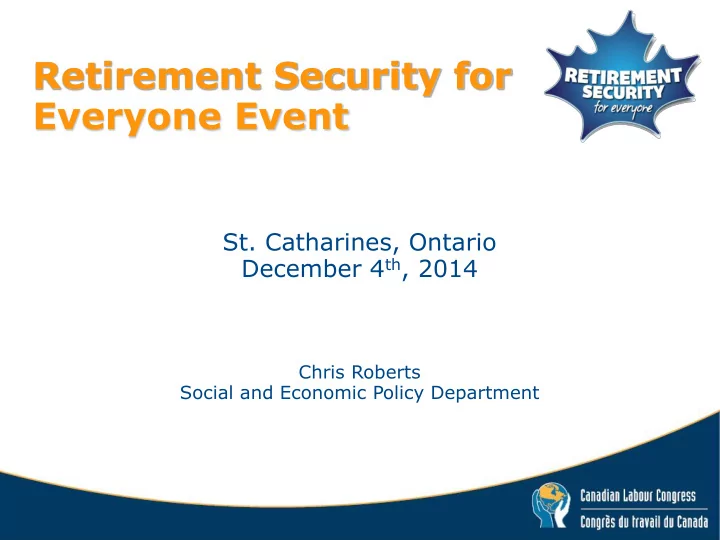

Retirement Security for Everyone Event St. Catharines, Ontario December 4 th , 2014 Chris Roberts Social and Economic Policy Department
Canada’s population is aging Number of seniors will double by 2036 By 2041, 1 in 4 Canadians will be over age 65
1973 2013 2058 7.8 working-age 2 working-age 4.5 working-age individuals per individuals per individuals per senior senior senior
Canadians are living longer
Seniors are healthier than ever Source: OECD
Canadians are working longer
But working longer is not a solution to the retirement income crisis • A quarter of fully-retired seniors left the workforce due to poor health or disability (Statistics Canada 2011) • Seven in ten (69%) retired Canadians did not finish their working career as planned or expected • Among those who did not retire as planned, 41% said health reasons were the primary reason for retiring early (Ipsos Reid survey, Oct 21, 2014)
A lot of retirements are coming • 3.6 million retirements are expected over the 2013- 2022 period (Canadian Occupational Projection System 2013 Projections) • But one in three Canadian adults (33.8%) are not preparing financially for retirement either on their own or through an employer pension plan (2014 Canadian Financial Capability Survey)
A significant number of households are facing a big drop in living standards in retirement Source: Ontario Ministry of Finance, Ontario’s Long -Term Report on the Economy, 2014
Why are Canadians unprepared for retirement?
Fewer workers have access to a pension at work Share of Ontario Workers with a Workplace Pension Plan 50 Overall 45 40 35 30 Private Sector Percent 25 20 15 10 5 0 1992 1994 1996 1998 2000 2002 2004 2006 2008 2010 2012 1991 1993 1995 1997 1999 2001 2003 2005 2007 2009 2011 Source: Statistics Canada, Pension Plans in Canada survey
Public pensions are too low
Old Age Security • Residency-based benefit payable at age 65 • Age 67 starting in 2029 • Must have lived in Canada minimum of 10 years after age 18 • Maximum benefits for 40 years residency after age 18 • Paid for through general revenue • $31.9 billion in OAS benefits (2013-14) • Maximum benefit: $563.74 per month • Average benefit in Ontario (Oct 2014): $529.42
Guaranteed Income Supplement • Income-tested benefit -- $17,088 cut-off (single person) • Payable at age 65 • Age 67 beginning in 2029 • Paid for through general revenue • $9.4 billion in benefits (2013-14) • Maximum benefit (single person): $764.40 per month • Average benefit in Ontario (Oct 2014): $506.65
Public pensions are too low
Our savings rate is half what it was 25 years ago and our indebtedness has doubled Source: Statistics Canada
We can achieve retirement security for everyone • Phased-in fully-funded doubling of future CPP benefits • Restore OAS and GIS at age 65 • Use a portion of the federal surplus to increase GIS benefits for our poorest seniors
The Canada Pension Plan The only workplace pension plan for 62% of Canadians 11 million workers have no savings plan at work other than CPP The Canada Pension Plan is: Completely portable Safe, secure and dependable Predictable Inflation-protected Paid until death – you can’t outlive your CPP benefit Provided at very low cost
What doubling future CPP benefits would mean • WITH LABOUR'S PLAN, a 25 year-old worker earning the average wage and salary and paying into the CPP from now until retirement at age 65 (40 years of expanded contributions) would earn a monthly CPP pension of about $2,077. • Without labour's plan, the same worker's monthly CPP payment would only be about $1,038.
What doubling future CPP benefits would mean • WITH LABOUR'S PLAN, a 45 year-old worker earning the average wage and salary and paying into the CPP from now until retirement at age 65 (20 years of expanded contributions) would earn a monthly CPP pension of about $1038. • Without labour's plan, the same worker's monthly CPP payment would only be about $519.
What would it cost? • An Ontario worker that earned an average of $30,000 over his or her lifetime would save an additional $1.86 per week in each year of the 7-year phase-in. • That means about 7.5 Timbits more each week in the first year, then 7.5 Timbits more each week in the second year, and so on, for 7 years. In return, your CPP benefit will be twice as high when you retire. • A similar worker earning an average of $50,000 over his or her working career would put aside an extra $3.27 each week -- about 13.2 Timbits -- in the first year.
1997 Reforms to CPP CPP contributions rose from 6.0% in 1997 to 9.9% in 2003 During the same period: Real GDP rose 23% Real investment rose 19% Employment grew 14% The unemployment rate fell from 9.1% in 1997 to 7.6% in 2003 -- and kept falling to 6.0% in 2007
Expanding CPP makes good economic sense Source: Statistics Canada, CANSIM 205-0002
The debate is settled – it’s time to expand CPP
Canada Labour Congress 2841 Riverside Drive Ottawa, ON K1V 8X7 www.canadianlabour.ca CR:sd:COPE225
Recommend
More recommend